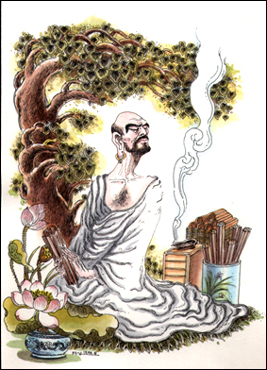| Contents
59. San Lun Sect (I)
59. San Lun Sect (I)
59.1 Name
San-lun [三論] is a pronunciation of
the Chinese words, which means Three Shastras, or Three Treatises,
so this sect is also known as Three Shastra Sect, or Three Treatise
Sect. Like many other sects, the three shastras are the principal
texts of this sect, from which the sect is named. The three shastras
are :
- Madhyamika-karikas Shastra [中論]
- Dvadasanikaya Shastra [十二門論]
- Shatashastra [百論]
There are many other names for this sect, such as Prajna Sect [般若宗],
Mahayana Emptiness Sect [大乘空宗],
Nature Sect [性宗], Dharma Nature Sect
[法性宗], all of which represent the
basic doctrines advocated by this sect.
59.2 Development
 San-lun
Sect is called to be the classical school, as it is inherited from
Madhyamika School in India. This sect may be traced back to Lokakshema,
who was the great translator in Han Dynasty, and was generally regarded
as the founder of Mahayana Buddhism in China. However, this sect
was first introduced and founded by another great translator Kumarajiva
(344-413 AD), who translated the Three Shastras, and spread its
doctrines in China. San-lun
Sect is called to be the classical school, as it is inherited from
Madhyamika School in India. This sect may be traced back to Lokakshema,
who was the great translator in Han Dynasty, and was generally regarded
as the founder of Mahayana Buddhism in China. However, this sect
was first introduced and founded by another great translator Kumarajiva
(344-413 AD), who translated the Three Shastras, and spread its
doctrines in China.
This sect was later organized by Master Tao-sheng (360-434 AD),
and instituted by Master Chia-hsiang. During Sui Dynasty, Master
Chih-tsang [吉藏] wrote commentaries
on the shastras, this sect was more popular. The patriarchs also
included The Commentary on Mahaprajna Paramita Sutra [大智度論]
in addition to the Three Shastras, as the principal text. Sometimes,
the four shastras are sometimes called the Four Shastras for San-lun
Sect.
This sect declined after the rise of Fa-hsiang Sect [法相宗],
but was later revived by Suryaprabhsa, an Indian monk who arrived
in China in 679 AD. When Chan Sect spread widely in later Tang Dynasty,
this sect faded out gradually.
59.3. Principal
Text
By its name, the principal text of this sect are the Three Shastra:
- Madhyamika-karikas Shastra [中觀論]
or simply Madhyamika Shastra [中論],
or Middle Treatise, written by Nagarjuna.
- Dvadasanikaya Shastra [十二門論]
or Twelve Gate Treatise, written by Nagarjuna.
- Shatashastra [百論] or One Hundred
Verses Treatise, written by Aryadeva.
All three shastras were translated into Chinese by Kumarajiva.
The first two were written by Nagarjuna who elaborated the meaning
of emptiness in the teaching of Middle Way, the essence of the Prajna
teaching of Shakyamuni Buddha.
The third one was written by Aryadeva. He was the follower of Nagarjuna,
who put forward all the arguments against Hinayana.
In Sui Dynasty, The Commentary on the Mahaprajna Paramita Sutra
was also included in the study of this sect.
59.4. Its
Classification of Buddhism
The masters of San-lun Sect classified the Buddha's teaching into
Two Baskets and Three Teachings.
Two Baskets are:
- Sound-hearer Basket, i.e. Hinayana, such as Agama.
- Bodhisattva Basket, i.e. Mahayana, such as Avatamsaka Sutra.
Three Teachings are:
- Fundamental Dharma Wheel -- just after the Enlightenment of
the Buddha, he preached for the Bodhisattva, i.e. Avatamasaka
Sutra. It is the fundamental teaching of all Dharmas, thus the
teaching of One Vehicle.
- Branch Dharma Wheel -- as it is difficult to understand the
profound teaching of One Vehicle, Shakyamuni preached Agama, Prajna,
Vaipulya teachings to his disciples. They are called branches
as they are derived from the fundamental one.
- Conclusive Dharma Wheel -- it refers to the preaching of the
Lotus Sutra, in which it declares that Three Vehicles converge
to One Buddha Vehicle.
59.5. Basic
Doctrine
The characteristic of the teaching in San-lun Sect is no-mark
and no-attachment.
By the time of Nagarjuna, they criticized and rejected almost all
other teachings:
- The false view of heterodox -- There are 96 kinds of heterodox,
such as views on false cause and false effect, views on no cause
and no effect, views on no cause but having effect, view on having
causes but no effect, etc.
- Attachment to All-existence as advocated by Adhidhrama -- They
criticized of the real existence of all Dharmas, thus the Four
Noble Truths as advocated in Adhidhrama-kosa. They said the devotees
of Ahdidharma did not understand the wonderful aim of the Buddha's
teaching, just like to see the finger, not the moon that the finger
points at.
- Attachment to Emptiness as advocated by Satyasiddhi -- They
criticized of the attachment of emptiness as there exists non-emptiness
with respect of emptiness.
- Attachment as advocated by Mahayana Buddhism -- They disputed
that there had no substantial attainment in Buddhahood, though
the devotees in Mahayana could benefit themselves and also benefit
others.
In order to rectify these false views, the practitioner should
understand the doctrines of the Double Truths and the Eight Negations
in Middle Way.
(Painting by Mi Hsiung)
|

 San-lun
Sect is called to be the classical school, as it is inherited from
Madhyamika School in India. This sect may be traced back to Lokakshema,
who was the great translator in Han Dynasty, and was generally regarded
as the founder of Mahayana Buddhism in China. However, this sect
was first introduced and founded by another great translator Kumarajiva
(344-413 AD), who translated the Three Shastras, and spread its
doctrines in China.
San-lun
Sect is called to be the classical school, as it is inherited from
Madhyamika School in India. This sect may be traced back to Lokakshema,
who was the great translator in Han Dynasty, and was generally regarded
as the founder of Mahayana Buddhism in China. However, this sect
was first introduced and founded by another great translator Kumarajiva
(344-413 AD), who translated the Three Shastras, and spread its
doctrines in China.

